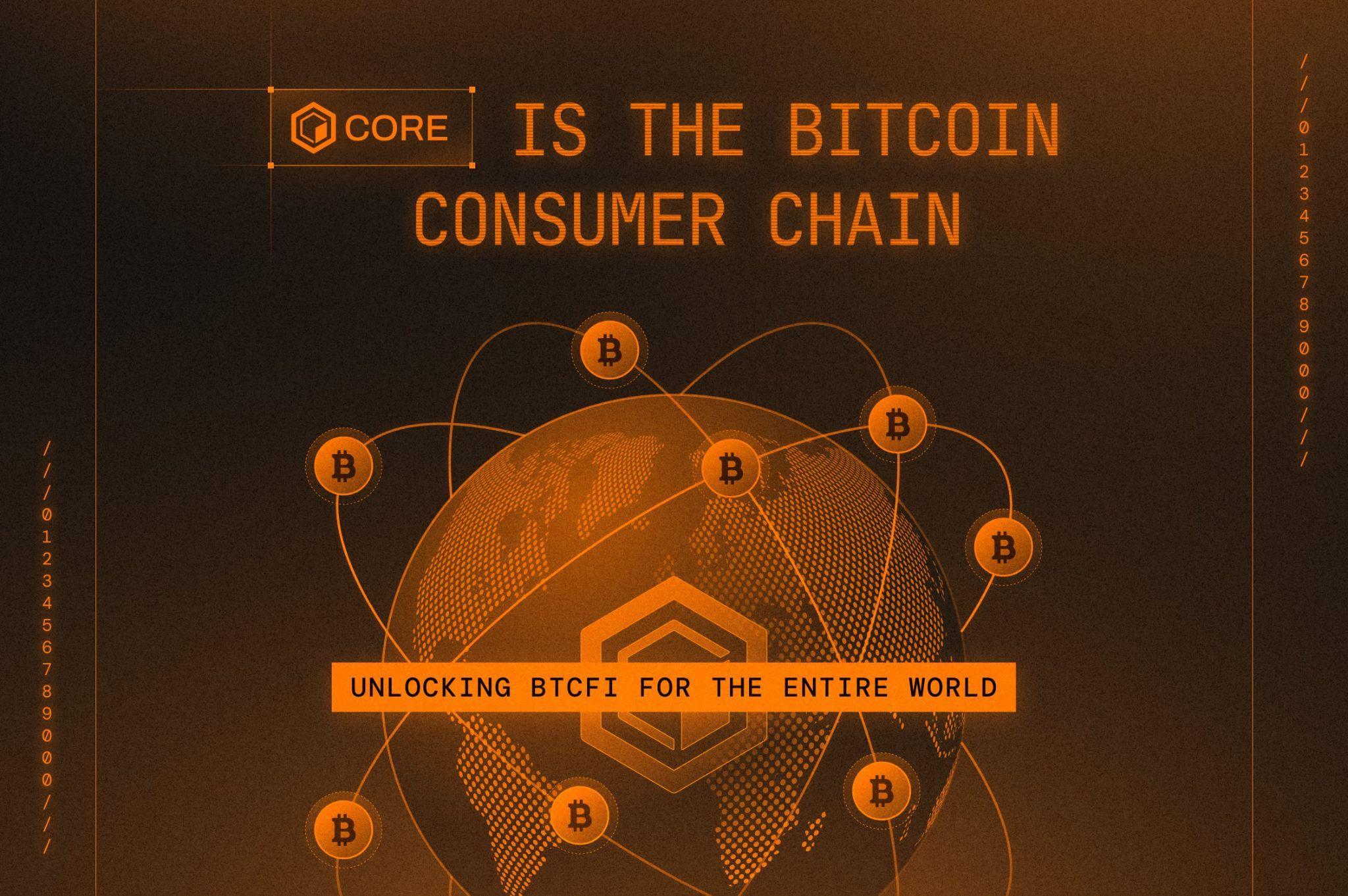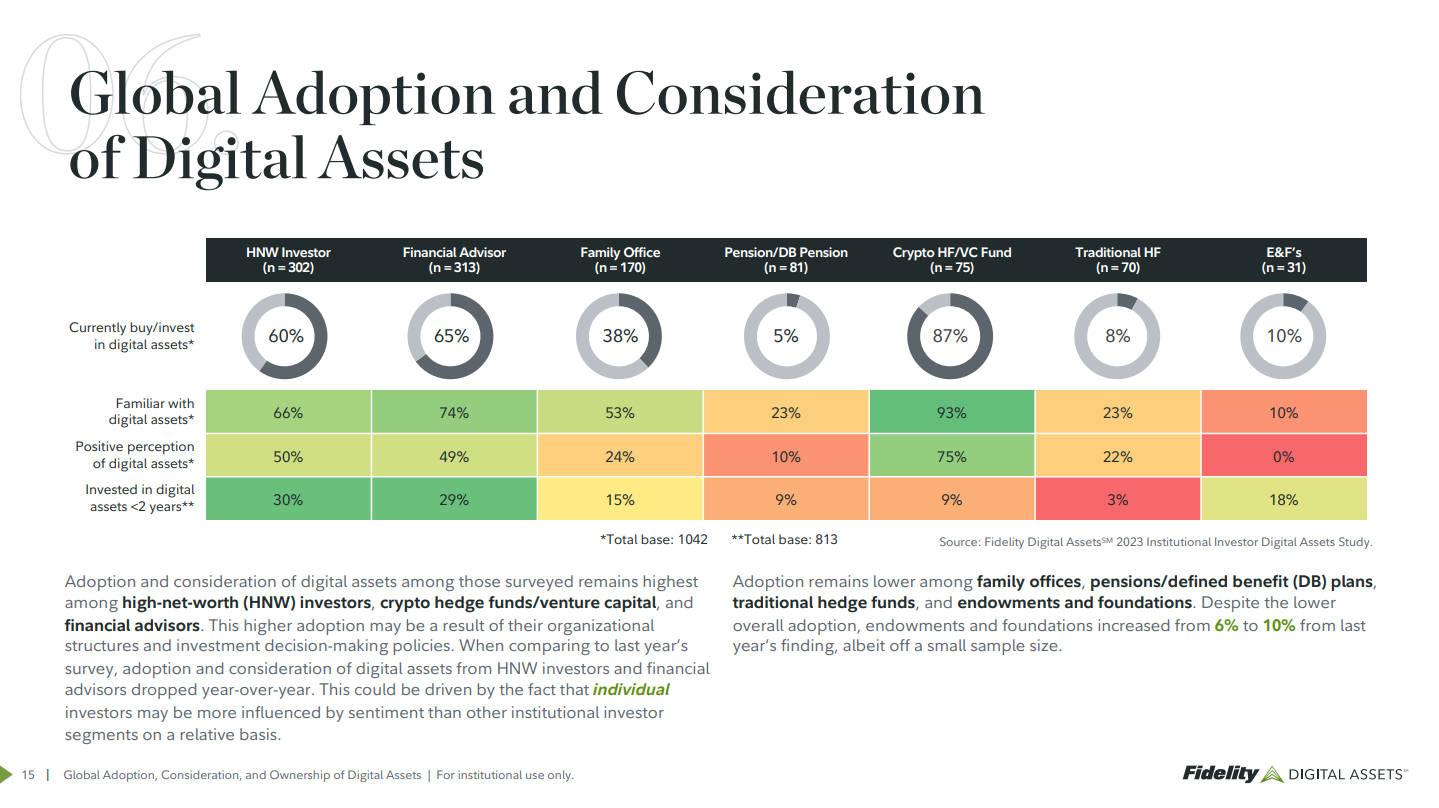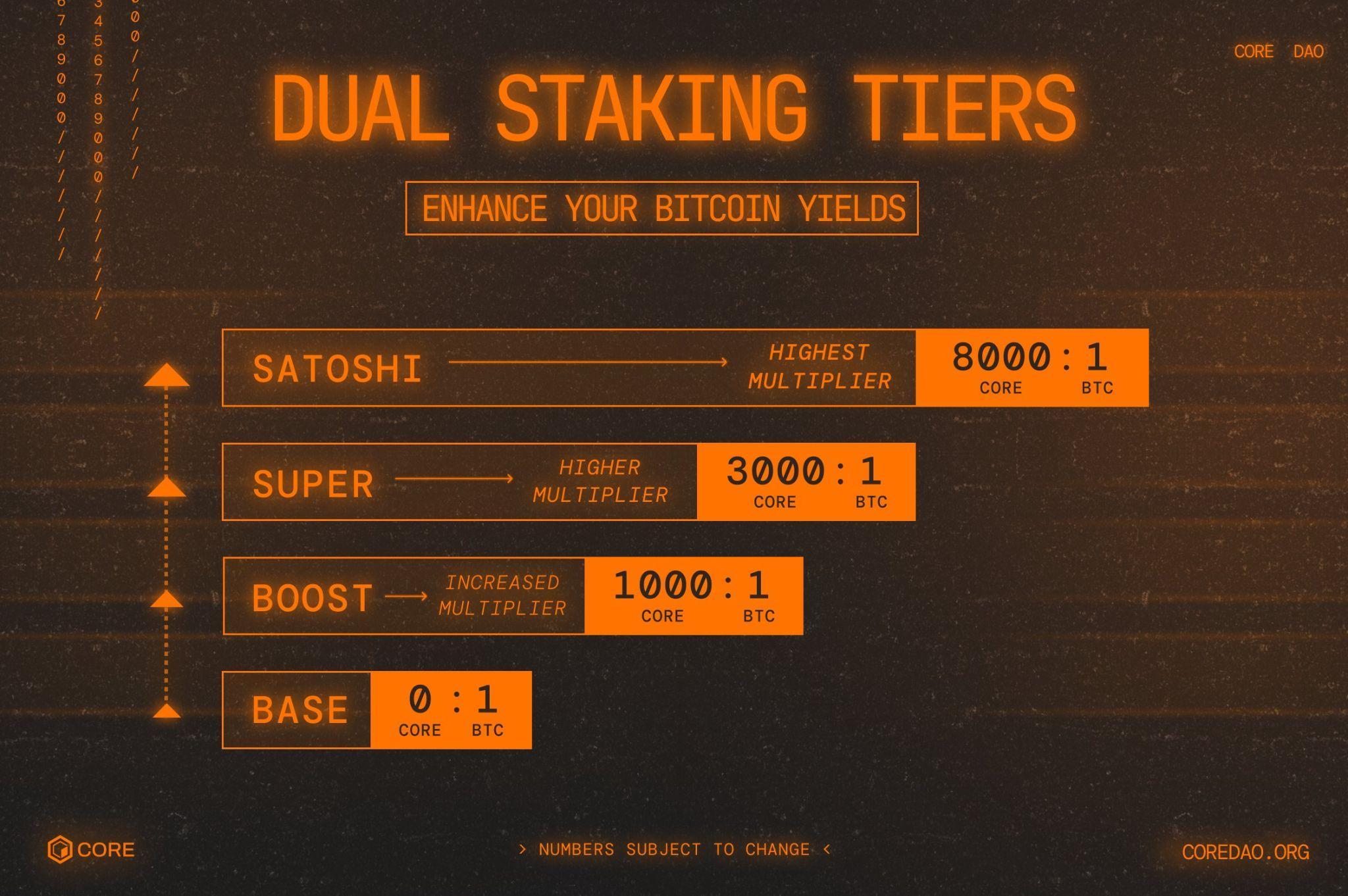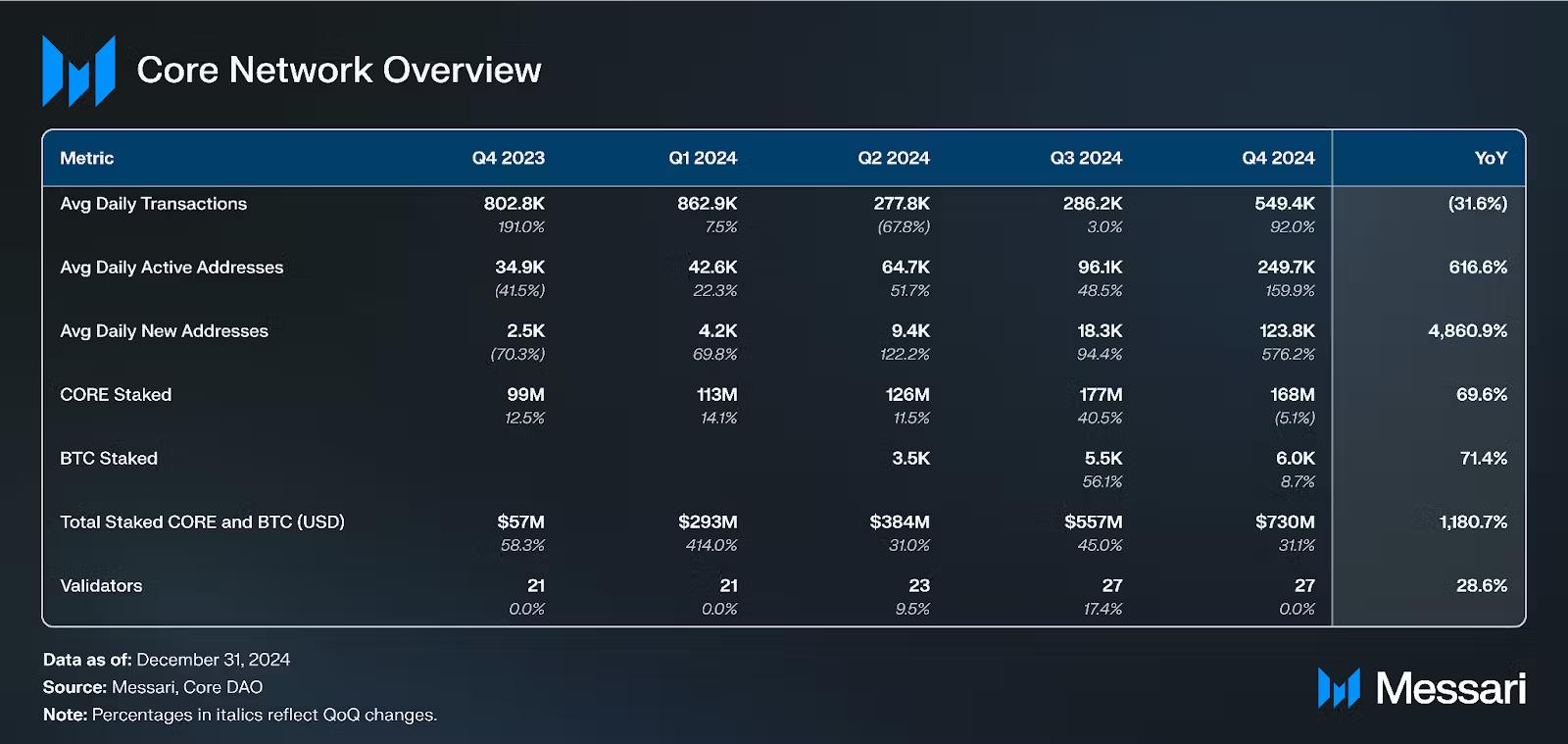
Author: Weilin, PANews
In the current cycle, institutional adoption of Bitcoin has become a highly discussed trend. A survey by Fidelity shows that there is a significant amount of untapped demand for Bitcoin adoption. Influenced by the approval of Bitcoin ETFs in the U.S. and a shift in regulatory policies, governments and large funds around the world are beginning to view Bitcoin as a strategic reserve asset. The U.S. may establish a Bitcoin strategic reserve, and an increasing number of countries and institutions may follow suit, potentially giving rise to a new financial paradigm. Institutional adoption of Bitcoin is at a critical turning point.
Core introduces dual staking through the Fusion upgrade, along with its yield-generating ETP and CoreFi strategies, providing solutions for real Bitcoin yields. Messari recently released growth indicators for Core in Q4 2024, showing a trend of Bitcoin transitioning from institutional investment to consumer chain as the user base expands. As of February 4, over 5,700 Bitcoins have been staked on Core's chain, with a total locked value exceeding $850 million.
Current Status of Institutional Investment in Bitcoin: Significant Untapped Demand at a Critical Turning Point
A survey result released by Fidelity Digital Assets in June 2024 indicates that institutional investors' interest in Bitcoin is gradually increasing. This survey was conducted among over 1,000 institutional investors worldwide in the previous year. In the survey, 60% of institutions indicated they have some understanding of digital assets, and 51% stated they are currently investing in digital assets. In 2019, only 39% of institutions had some understanding of digital assets, and among U.S. investors in 2019, only 22% were investing in digital assets.

A deeper analysis of this data reveals two types of investors. On one hand, there are individual-driven institutional investors, such as high-net-worth individuals, investment advisory firms, crypto hedge funds/VCs, etc., with 70-80% already investing in digital assets. On the other hand, there are large institutions, such as pension funds, traditional hedge funds, endowment funds, and foundations, unfortunately, this proportion remains in the single digits. Currently, Bitcoin's market capitalization is approximately $2 trillion, and institutional adoption of Bitcoin is at a critical turning point, with significant untapped demand.
In 2024, well-known institutions such as Strategy (formerly MicroStrategy), BlackRock, ARK Invest, and Fidelity have enhanced Bitcoin's market presence through strategic investments and innovative financial products (such as Bitcoin ETFs). As of January 24, Strategy holds 471,107 Bitcoins, with a total cost of approximately $30.4 billion. Throughout 2024, the company also purchased an additional 258,320 Bitcoins.
With the approval of Bitcoin spot ETFs and the Trump administration's support for crypto assets, more large companies and institutions are beginning to adopt Bitcoin reserve plans. Companies like Strategy, MARA Holdings, and Riot Platforms are incorporating Bitcoin into their financial reserves, and cryptocurrency is gradually becoming part of mainstream dialogue. Under the leadership of the new U.S. government, both state and federal levels are exploring plans for Bitcoin as a reserve asset, and new regulatory models are expected to further promote institutional adoption of Bitcoin.
From an asset characteristics perspective, Bitcoin offers high returns (9800% return over 8 years), although it comes with high risks and volatility, its low correlation with traditional assets makes it an ideal tool for portfolio diversification. Compared to traditional alternative assets like real estate and art, Bitcoin has clear advantages in liquidity, transparency, and divisibility.
How Core Enhances Real Yield Solutions: Fusion Upgrade Introduces Dual Staking, Yield-Generating ETP and CoreFi Strategies
Institutions invest through direct purchases, Bitcoin futures, ETFs, custody services, BTCFi, and Bitcoin-related stocks. Core provides institutions with the option to stake BTCFi, allowing them to earn yields safely and stably.
In April 2024, Core blockchain integrated non-custodial Bitcoin staking for the first time, enabling users to stake Bitcoin and earn yields while fully retaining control over their assets. This native mechanism generates Bitcoin yields without requiring additional trust assumptions.
On November 19, 2024, Core launched the Fusion upgrade, which PANews previously introduced as bringing new market opportunities in the Bitcoin ecosystem. The launch of dual staking products aims to address the balance of community reward distribution issues that may arise when Bitcoin stakers lock their assets and receive CORE token rewards through validation nodes. Especially in cases where institutions stake large amounts of Bitcoin, the released CORE rewards will correspondingly increase. Against this backdrop, to encourage Bitcoin stakers to re-stake the CORE rewards they receive back to validation nodes, dual staking enhances user participation willingness by offering higher annual percentage yields (APY).
To further enhance yield generation from non-custodial Bitcoin staking, the dual staking mechanism unlocks higher yield tiers by staking both Bitcoin and CORE tokens simultaneously. Since the daily CORE emission is fixed, users staking both Bitcoin and CORE will receive higher reward tiers. The increase in rewards is linked to the number of staked CORE tokens, encouraging Bitcoin stakers to engage more deeply in the Core ecosystem and maximize returns for loyal users.

Recently, Core also launched yield-generating Bitcoin exchange-traded products (ETP) for the first time, providing investors with the opportunity to earn yields through non-custodial Bitcoin staking. In collaboration with Valour, a subsidiary of DeFi Technologies, this ETP offers investors a yield of 5.65%, becoming an important avenue for institutional investors to enter the BTCFi ecosystem.
On February 4, DeFi Technologies reached a binding letter of intent with CoreFi Strategy and Orinswift Ventures to promote a reverse acquisition, allowing the common stock of the merged entity to be listed on the Cboe Canada Securities Exchange. The Core Foundation will contribute CORE tokens valued at $20 million to enhance CoreFi's financial reserves. At the same time, CoreFi plans to raise $20 million through synchronous financing to accelerate its development in the BTCFi technology sector.
Additionally, Core has established partnerships with custody service providers such as Fireblocks, Copper, Cactus, and Hashnote to support dual staking. Inspired by the successful experiences of Strategy and Metaplanet, CoreFi strategies provide regulated investment methods for institutional investors, achieving leveraged Bitcoin and CORE yields.
On February 18, the Core Foundation announced the launch of lstBTC in collaboration with Maple Finance, BitGo, Copper, and Hex Trust. lstBTC will become a new type of liquidity, yield-bearing Bitcoin token on the Core blockchain, designed specifically for institutions, aimed at generating yields from idle Bitcoins. By converting Bitcoin into productive assets, lstBTC provides holders with a way to transform billions of dollars into yields while maintaining security, compliance, and liquidity.
Institutions can mint lstBTC by depositing Bitcoin into trusted custodians like BitGo, Copper, or Hex Trust. lstBTC generates yields while maintaining full liquidity—institutions can trade, transfer, or use lstBTC as collateral. Upon redemption, holders will receive their original Bitcoin along with proportionally calculated yields, directly deposited into their custody accounts.
The uniqueness of lstBTC includes:
Unlike other Bitcoin yield solutions, lstBTC is designed specifically for institutions, requiring no asset transfer or unnecessary risk.
No changes to custody arrangements are needed—institutions can continue to store Bitcoin with their existing custodians.
Real BTC yields—yields denominated in BTC are obtained through Core's dual staking mechanism without transferring Bitcoin out of the custodian.
Fully liquid and scalable—lstBTC can be traded, transferred, or used as collateral while the underlying Bitcoin continues to generate yields.
Designed for institutional use cases—seamlessly integrated into existing and new portfolio strategies to enhance returns.
Data-Driven New Trends: Core Leads Bitcoin Adoption, Transitioning from Institutional Investment to Consumer Chain
As the hype and speculation gradually fade, the blockchain sector is leaning towards focusing on real applications and genuine user growth. Core is becoming the consumer chain for Bitcoin, driving the practical application of Bitcoin and achieving sustained user growth.
According to a third-party report from the well-known research firm Messari, in Q4 2024, Core's DeFi TVL (in USD) grew by 90% quarter-over-quarter, reaching $811.8 million. Avalon Labs ranks first in the DeFi TVL leaderboard, followed by Colend and Pell Network. Pell Network launched the Bitcoin restaking feature in August, bringing new growth momentum to the Core ecosystem.

Core and BTC staking (in USD) grew by 31% quarter-over-quarter, reaching $730.5 million. The growth is primarily attributed to the staking of 500 Bitcoins through Core's non-custodial Bitcoin staking product, which was launched in April.
Core's daily active address count increased by 160% quarter-over-quarter, reaching 249,700. By the end of Q4, the total number of independent wallets on Core reached 34.8 million. Fees increased by 97% quarter-over-quarter, reaching $235,000.
In Q4, Core released the Fusion upgrade, launching dual staking and introducing lstBTC. In Q4, a total of 1,298 Bitcoins and 16.5 million CORE were dual staked, accounting for 22% and 19% of all Bitcoins and CORE staked on the Core network, respectively.
From a data performance perspective, Core has achieved genuine user growth and sustained demand for block space, leading its competitors. Looking ahead, Core's focus in Q1 will be to further develop relationships with custody/institutional partners.
As the Bitcoin ecosystem shows a trend towards a consumer chain, Core is leading this transformation, promoting the real application and popularization of the Bitcoin ecosystem. Through innovative staking mechanisms, yield-generating financial products, and a strong partner network, Core not only provides stable yield channels for institutional investors but also creates more participation opportunities for ordinary users. In the future, as the regulatory environment gradually clarifies and technology continues to advance, Core is expected to continue playing an important role in driving the transition of Bitcoin from an investment tool to a consumer chain.
免责声明:本文章仅代表作者个人观点,不代表本平台的立场和观点。本文章仅供信息分享,不构成对任何人的任何投资建议。用户与作者之间的任何争议,与本平台无关。如网页中刊载的文章或图片涉及侵权,请提供相关的权利证明和身份证明发送邮件到support@aicoin.com,本平台相关工作人员将会进行核查。




